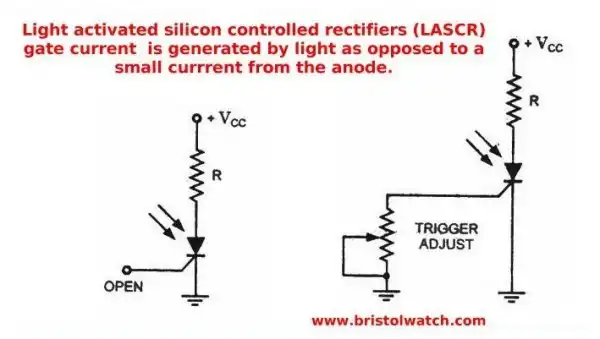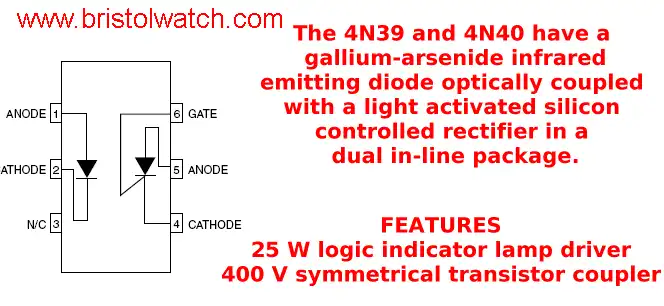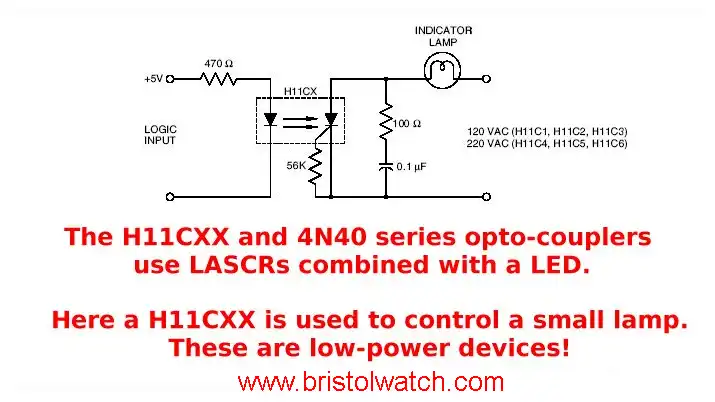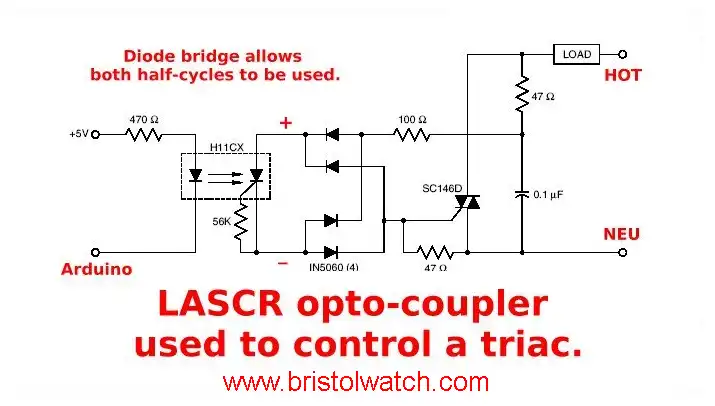
What is a Light Activated Silicon Controlled Rectifier? (LASCR)
by Lewis Loflin
A light activated silicon controlled rectifier (LASCR) is a silicon controlled rectifier (Thyristor) that conducts when the gate is exposed to light. The gate still operates as a normal gate in a SCR, but is in many cases left disconnected. LASCR is a unidirectional device that conducts current in only direction. The basic LASCR circuit is illustrated above. Like all SCRs and triacs one must use A.C. or pulsating D.C. for proper operation. Also see Basic SCRs/Triacs.

While the light source to activate a LASCR can be a simple flashlight or light bulb, the source is often a light emitting diode or LED as illustrated above.
Illustrated above a LED and LASCR in the same package. This often six-pin device is called an opto-coupler. These devices provide electrical isolation between the input and output circuits. In the case of the of the H11Cx series illustrated above this will provide isolation of up to 5300 volts RMS. Also H11C6 SCR opto-Coupler (PDF file)

In the above circuit we are using a H11C6 opto-coupler to directly drive a small-watt light bulb. The SCR section of the opto-coupler is rated at 400 volts at 300 milliamps. (mA) Note that being a unidirectional device, the SCR will provide only half-wave rectification and the bulb will only be about half as bright. The input can be controlled from 5-volt computer logic.

Finally in the above circuit we are using a H11C6 through a diode bridge to switch on a triac. This circuit operates as full wave and delivers max power to the load.

- Quick navigation of this website:
- You Tube Channel
- Basic Electronics Learning and Projects
- Basic Solid State Component Projects
- Arduino Microcontroller Projects
- Raspberry Pi Electronics, Programming
Also see Simple DIAC Based Relaxation Oscillator Pulse Generator
- Basic Triacs and SCRs
- Solid State AC Relays with Triacs
- Light Activated Silicon Controlled Rectifier (LASCR)
- Light Activated SCR Based Optocouplers Circuit Examples
- Comparing Photo Triac, Photo SCR Opto-Couplers
- Silicon Controlled Rectifier Review and Circuits
- Silicon Controlled Rectifiers Connected as Power Triacs
- Simple Triac-SCR Test Lab for You Tube
- Connecting Transformers in Series-Parallel
- Build an Adjustable 0-34 volt power supply with the LM317
- AC Power Supply Rectification
- Basic Power Transformers
- Transistor-Zener Diode Regulator Circuits
- Tips for the LM78XX Series Voltage Regulators
- Bi-Polar Power Supplies
- Connecting Series-Parallel Batteries
- Build Autotransformer-Variac AC and DC Power Supply
- Understanding Unijunction Transistors Theory Operation
- Unijunction Transistor SCR Photo Flash Control Circuit
Web site Copyright Lewis Loflin, All rights reserved.
If using this material on another site, please provide a link back to my site.